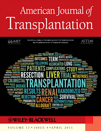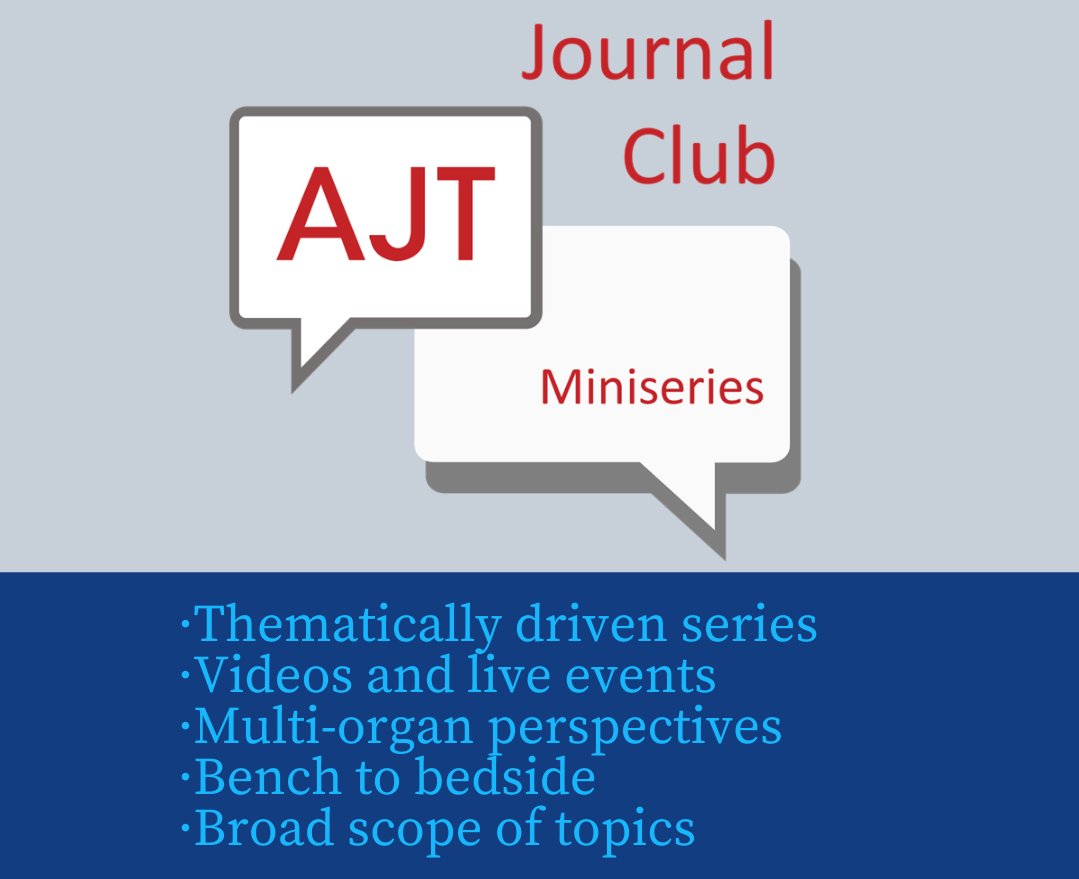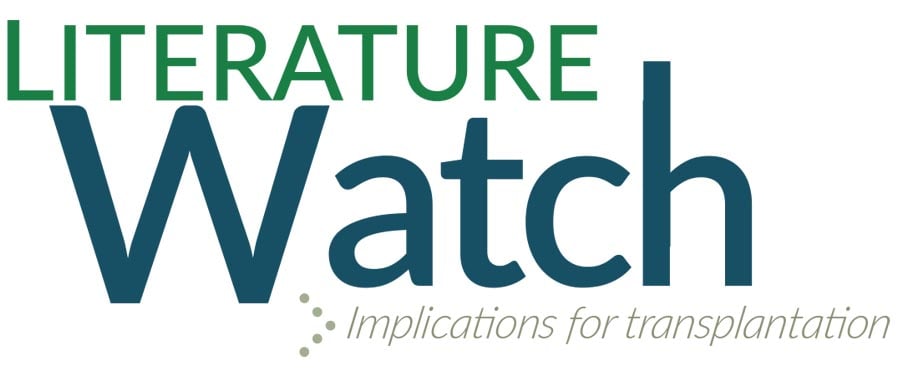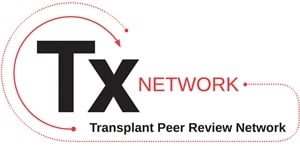Journal list menu
Export Citations
Download PDFs
The AJT Report
The AJT Report: News and issues that affect organ and tissue transplantation
- Pages: 641-642
- First Published: 29 March 2011
This month, we take an in-depth look at Arizona's decision to deny coverage for certain transplants, and hear responses to the controversial legislation from leaders in the field of transplantation.
Literature Watch
LITERATURE Watch
- Page: 643
- First Published: 29 March 2011
Members of the Predictive Safety Testing Consortium undertook a comprehensive preclinical study of renal toxins to develop more sensitive and specific biomarkers of renal function and injury. The results are illuminating and point the way to alternative measures of renal injury and function.
Editorials
Organized Staffing Directed by Intensivists Improves Outcomes for Critically Ill Patients
- Pages: 645-646
- First Published: 29 March 2011
The best available data support the view that organized staffing of intensive care units, under the direction of intensivists, improves outcomes for critically ill patients. See special article by Ranjan et al on page 670.
Revisiting the Natural History of IF/TA in Renal Transplantation
- Pages: 647-649
- First Published: 29 March 2011
This editorial discusses the natural history of IF/TA, with specific reference to the progress of immunosuppressive regimens and input of molecular phenotyping. See articles by Stegall et al (page 698) and Mengel et al (page 708).
Calculated PRA: A Process Whose Time Has Come or ‘Déjà vu’ All Over Again?
- Pages: 650-651
- First Published: 14 March 2011
The implementation of calculated PRA has been a success and is changing clinical practice; however, the concept is not new and there remains room for improvement. See article by Cecka et al on page 719.
If You're Not Fit, You Mustn't Quit: Observational Studies and Weighing the Evidence
- Pages: 652-653
- First Published: 29 March 2011
While observational studies are important in transplantation, inferences from nonrandomized trials that seem contrary to putative biological mechanisms must be made with great care. See article by Molnar et al on page 725.
Minireviews
Paradoxical Aspects of Rapamycin Immunobiology in Transplantation
- Pages: 654-659
- First Published: 29 March 2011
The authors review recent findings concerning the at times paradoxical effects of mTOR inhibition through rapamycin on CD4+ and CD8+ T cell responses in transplantation and protective immunity.
Crosstalk between Complement and Toll-like Receptor Activation in Relation to Donor Brain Death and Renal Ischemia-Reperfusion Injury
- Pages: 660-669
- First Published: 29 March 2011
This review discusses the innate immune interplay between complement and Toll-like receptor activation in relation to pretransplant renal injury by donor brain death and early posttransplant renal ischemia-reperfusion injury.
Special Articles
American Society of Transplant Surgeons’ White Paper: Impact of Closed ICUs on Transplant Patients’ Care
- Pages: 670-671
- First Published: 29 March 2011
The ASTS takes a stand that the current move towards “closed” ICUs is unwarranted and may be detrimental in the care of transplant patients, and that many transplant surgeons function well in the role of intensivist for their patients. See editorial by Fink on page 645.
Screening and Treatment of Chagas Disease in Organ Transplant Recipients in the United States: Recommendations from the Chagas in Transplant Working Group
- Pages: 672-680
- First Published: 14 March 2011
A multidisciplinary working group presents evidence-based recommendations for donor screening and follow-up testing and treatment of organ recipients from infected living and deceased donors with Chagas disease.
Meeting Report
Report of a Joint ESOT and AST Meeting: Highlights in Biologic Agents and Transplantation
- Pages: 681-686
- First Published: 29 March 2011
The authors report on an international meeting focusing on advances in immunology and biologics, jointly sponsored by AST and ESOT, held in Nice, France, in October 2010.
Personal Viewpoints
Chronic Progressive Calcineurin Nephrotoxicity: An Overstated Concept
- Pages: 687-692
- First Published: 29 March 2011
The author questions the significance of calcineurin inhibitors in posttransplant kidney dysfunction. See rhetorical viewpoint by Chapman on page 693.
Chronic Calcineurin Inhibitor Nephrotoxicity—Lest We Forget
- Pages: 693-697
- First Published: 29 March 2011
Reviewing the data that lead to the conclusion that chronic CNI nephrotoxicity contributes to loss of kidneys in the long term, the author reviews data from the last 3 decades to understand the issues of today. See rhetorical viewpoint by Matas on page 687.
Original Articles
Clinical Science
The Histology of Solitary Renal Allografts at 1 and 5 Years After Transplantation
- Pages: 698-707
- First Published: 09 November 2010
This study of protocol renal allograft biopsies suggests that chronic histologic changes at 5 years are less severe than previously reported, and that mild fibrosis present at 1 year does not commonly progress to more severe forms. See editorial by Brouard et al on page 647.
The Molecular Phenotype of 6-Week Protocol Biopsies from Human Renal Allografts: Reflections of Prior Injury but Not Future Course
- Pages: 708-718
- First Published: 29 November 2010
The molecular phenotype in 6-week protocol biopsies correlates with subclinical infiltrates and tubulitis by histology, but shows a strong association with prior DGF but not future outcome. See editorial by Brouard et al on page 647.
Calculated PRA: Initial Results Show Benefits for Sensitized Patients and a Reduction in Positive Crossmatches
- Pages: 719-724
- First Published: 29 November 2010
The virtual crossmatch has substantially reduced the number of deceased donor kidney offers that are declined in the US because of a positive actual crossmatch, and has improved the access to transplants for sensitized candidates. See editorial by Bray et al on page 650.
Associations of Body Mass Index and Weight Loss with Mortality in Transplant-Waitlisted Maintenance Hemodialysis Patients
- Pages: 725-736
- First Published: 29 March 2011
The authors examined the association of changes in pretransplant BMI or muscle mass with mortality in 14,632 hemodialysis patients over 6 years of kidney transplant waitlisting period (2001–2007) and found that lower BMI or muscle mass and/or unintentional weight or muscle loss were associated with higher mortality. See editorial by Segev et al on page 652.
Living Kidney Donors: Impact of Age on Long-Term Safety
- Pages: 737-742
- First Published: 29 March 2011
Live kidney donation by the elderly is considered, demonstrating that the decline in eGFR is similar in younger and older donors.
Accepting Kidneys from Older Living Donors: Impact on Transplant Recipient Outcomes
- Pages: 743-750
- First Published: 14 March 2011
Based on analysis of large Canadian healthcare databases, recipients of older living donor kidneys had 4-year total graft survival similar to recipients of standard criteria deceased donor kidneys, but showed a trend towards potential differences when compared to recipients of younger living donor kidneys.
Improved Survival with Recent Post-Transplant Lymphoproliferative Disorder (PTLD) in Children with Kidney Transplants
- Pages: 751-758
- First Published: 29 March 2011
This study demonstrates improved patient survival in more recent cases of posttransplant lymphoproliferative disease cases, with relatively worse survival in cases that occurred beyond 1 year postransplant or in older children.
Operative Risks of Domino Liver Transplantation for the Familial Amyloid Polyneuropathy Liver Donor and Recipient: A Double Analysis
- Pages: 759-766
- First Published: 29 March 2011
This study of domino liver transplantation shows that familial amyloid polyneuropathy donors are not exposed to higher operative risks compared to nondonor patients, and recipients of such grafts have no higher operative risks compared to cadaveric liver recipients.
Characterization of the Cross-Neutralizing Antibody Response Against Hepatitis C Virus in the Liver Transplantation Setting
- Pages: 767-774
- First Published: 14 March 2011
This study of liver allograft recipients with hepatitis C virus suggests that viral adaptation may account for early viral kinetics following liver transplantation.
Characterization of HCV-Specific CD4+Th17 Immunity in Recurrent Hepatitis C–Induced Liver Allograft Fibrosis
- Pages: 775-785
- First Published: 29 March 2011
This study demonstrates that recurrent hepatitis C virus infection following orthotopic liver transplantation leads to increased IL-6, IL-1β and decreased IFN-γ which induces hepatitis C virus specific CD4+Th17 cells, which may play a role in allograft fibrosis and cirrhosis.
rPSGL-Ig for Improvement of Early Liver Allograft Function: A Double-Blind, Placebo-Controlled, Single-Center Phase II Study
- Pages: 786-797
- First Published: 14 March 2011
Treatment with rPSGL-Ig, a P-selectin antagonist, improved early liver allograft function in a double-blinded, placebo-controlled, single-center Phase II study, in association with decreased IP-10 and augmented IL-10 expression.
The Economic Implications of Broader Sharing of Liver Allografts
- Pages: 798-807
- First Published: 14 March 2011
Use of national registry and integrated cost accounting data to assess the economic impact of alternative liver allograft sharing simulations supports the premise that broader sharing of liver allografts offers a cost-effective strategy to reduce the mortality from end-stage liver disease.
Long-Term Follow-Up in Composite Tissue Allotransplantation: In-Depth Study of Five (Hand and Face) Recipients
- Pages: 808-816
- First Published: 29 March 2011
Using the available technology to study four bilateral hand allografts and a partial facial allograft, the authors did not find evidence of chronic immune mediated graft injury.
Association of HLA Polymorphisms with Post-transplant Lymphoproliferative Disorder in Solid-Organ Transplant Recipients
- Pages: 817-825
- First Published: 14 March 2011
The authors analyze a large cohort of solid organ transplant recipients and demonstrate novel associations between specific HLA polymorphisms and the risk to develop post-transplant lymphoproliferative disease.
Brief Communications
Coexpression of Donor Peptide/Recipient MHC Complex and Intact Donor MHC: Evidence for a Link between the Direct and Indirect Pathways
- Pages: 826-831
- First Published: 14 March 2011
Donor passenger leukocytes exchange MHC molecules with the recipient, resulting in antigen presenting cells expressing both donor and recipient MHC; this includes recipient MHC molecules presenting donor derived allopeptides, thus providing a link between the direct and indirect antigen presentation pathways.
Essential Role of PDL1 Expression on Nonhematopoietic Donor Cells in Acquired Tolerance to Vascularized Cardiac Allografts
- Pages: 832-840
- First Published: 14 March 2011
PDL1 expression on nonhematopoietic donor cells, particularly endothelium, plays an essential role in controlling the alloimmune response and in inducing tolerance in vascularized cardiac allografts.
Donor-Directed MHC Class I Antibody Is Preferentially Cleared from Sensitized Recipients of Combined Liver/Kidney Transplants
- Pages: 841-847
- First Published: 29 March 2011
Donor-directed MHC class I antibody is preferentially cleared, relative to class II antibody, in sensitized recipients of combined liver/kidney transplants.
Organ Donor Screening Practices for Trypanosoma cruzi Infection among US Organ Procurement Organizations
- Pages: 848-851
- First Published: 22 March 2011
All US organ procurement organizations responded to a survey describing their donor screening practices for Trypanosoma cruzi infection and organ utilization from seropositive donors.
Case Reports
Renal Transplantation for Fibromuscular Dysplasia
- Pages: 852-856
- First Published: 29 March 2011
The authors report a case in which a living related renal transplantation was performed as rescue treatment for therapy-resistant renovascular hypertension due to fibromuscular dysplasia.
The Importance of Portal Venous Blood Flow in Ischemic-Type Biliary Lesions after Liver Transplantation
- Pages: 857-862
- First Published: 14 March 2011
This study describes the relation between the development of post–liver transplant portal vein thrombosis and ischemic-type biliary lesions, revealing portal vein thrombosis as a risk factor for developing ischemic-type biliary lesions.
Reports from the CDC: MMWR
Potential Transmission of Viral Hepatitis Through Use of Stored Blood Vessels as Conduits in Organ Transplantation—Pennsylvania, 2009
- Pages: 863-865
- First Published: 29 March 2011
As detailed in this report, stored vessels from donors with hepatitis may be a potential source of donor-derived hepatitis when used in transplant recipients.
Letters to the Editor
The Need for Better Understanding of Transplant Glomerulitis
- Page: 866
- First Published: 14 March 2011
Chronic Lymphocytic Leukemia in Kidney Recipients
- Pages: 867-868
- First Published: 14 March 2011
A Rare Variation of the Biliary Tree of Relevance to Live Liver Donation
- Pages: 869-870
- First Published: 29 March 2011










.jpg)
